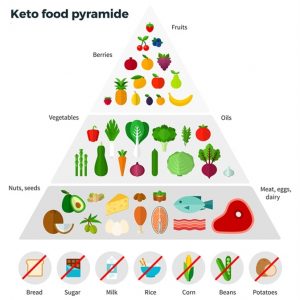Every medical professional knows that it is not a matter of ‘if’, but ‘when’ ketoacidosis will appear in clinical scenarios. Ketoacidosis is a metabolic disorder triggered by an unbalanced diet and an over-production of ketones. As an ever-increasing reality, it is essential to gain an understanding of the medical conditions surrounding ketoacidosis. In this article, we will explore the clinical reality of ketoacidosis and what to look for in treatment and prognosis.
Table of Contents
- 1. What is Ketoacidosis?
- 2. Clinical Recognition and Diagnosis of Ketoacidosis
- 3. Risk Factors and Complications of Ketoacidosis
- 4. Treatments for Ketoacidosis
- 5. Preparing for A Healthy Ketoacidosis-Free Future
- Q&A

1. What is Ketoacidosis?
Ketoacidosis is a serious, potentially life-threatening medical condition that occurs when your body has too many ketones—molecules produced in the body when it breaks down fat to use for energy instead of glucose. It can happen to both type 1 and type 2 diabetes patients, and is especially dangerous for those with type 1 diabetes who don’t have enough or any insulin produced in their bodies.
- Someone with ketoacidosis will have too many ketones in their blood stream.
- They will also have too little insulin in their body.
- This can cause the pH levels in their blood to become too acidic.
If left untreated, ketoacidosis can lead to serious health complications such as coma, organ damage, or even death. So, it’s essential to get help from a doctor immediately if you suspect you or a loved one has this condition. Treatment for ketoacidosis typically involves restoring the balance of fluids, electrolytes, and insulin in the body through intravenous fluids or a medicine called insulin. Regular monitoring and medical check-ups are important in order to prevent ketoacidosis occurring again.
2. Clinical Recognition and Diagnosis of Ketoacidosis
Ketoacidosis is a serious medical condition that is primarily diagnosed in people with diabetes. Because symptoms often go unnoticed or unrecognized, proper diagnosis is important in order to prevent serious complications. The involves several key components.
Identifying Symptoms
- Excessive thirst
- Frequent urination
- Nausea and/or vomiting
- Abdominal pain
- Fatigue
Misdiagnosis is a common problem when dealing with the symptoms of ketoacidosis. It is important to recognize that the symptoms of ketoacidosis are similar to other conditions, including gastrointestinal issues or food poisoning.
Laboratory Testing
- Blood glucose levels
- Urine test to assess ketone levels
- Reticulocyte count
- Serum electrolyte levels
Testing can provide a more accurate diagnosis, and is a common way to differentiate ketoacidosis from other potential diagnoses. It is important to understand that laboratory testing is only a diagnostic tool, and is not the only way to diagnose ketoacidosis.
3. Risk Factors and Complications of Ketoacidosis
Ketoacidosis: What You Need to Know
Ketoacidosis is a serious, life-threatening complication that can occur when following a ketogenic diet. It can be caused by a number of factors, including dehydration and unbalanced electrolyte levels. People who are sick or have pre-existing health conditions are at particularly high risk.
Ketoacidosis is a medical emergency, and it’s important to be aware of the potential symptoms and the steps you can take to reduce your risk. Common signs and symptoms of ketoacidosis include:
- Frequent thirst, exhaustion, and frequent urination
- Heavy breath
- Abdominal pain
- Fruity breath
- Confusion or disorientation
If you experience any of these symptoms, don’t hesitate to seek medical attention. In some cases, ketoacidosis can lead to coma or death. To reduce your risk of ketoacidosis, you should maintain a well-balanced diet, stay hydrated, and get regular medical check-ups. Additionally, limit alcohol consumption and avoid fasting for long periods of time. Following these steps and knowing the warning signs of ketoacidosis can help you stay safe and healthy while on a ketogenic diet.
4. Treatments for Ketoacidosis
If left untreated, ketoacidosis can be a life-threatening condition, so it is imperative to receive treatment immediately. The focus on restoring the body to a more normal metabolic state and restoring the body’s acid-base balance.
The primary treatment for ketoacidosis is intravenous fluid replacement. This helps to restore any lost fluids due to vomiting or excessive urination. Insulin, either as injection or an insulin drip, is also essential for helping a patient’s body move glucose into the cells for energy. Other medications may also be administered, such as potassium or sodium bicarbonate, to help restore the body’s pH balance. In addition, to replace electrolytes lost during the ketoacidosis process, doctors may administer sodium chloride, potassium chloride, calcium chloride, and magnesium sulfate fluid replacement intravenously.
- Intravenous fluid replacement
- Insulin as an injection or an insulin drip
- Potassium or sodium bicarbonate
- Electrolyte replacements
5. Preparing for A Healthy Ketoacidosis-Free Future
Once you’ve been through the ketoacidosis experience, the best thing you can do for yourself is prepare for a healthy future. Here are 5 steps on how to make that happen:
- Educate Yourself: Learn everything you can about ketoacidosis and diabetes, as this will help you understand what happened and why. Read up on diabetes management and ketoacidosis prevention to take an active role in your health.
- Check Your Blood Sugar: Be sure to test your blood sugar regularly to make sure you’re in the safe range. Your doctor can help you find the best plan that works with your lifestyle and schedule.
- Collaborate With Your Doctor: Get in touch with your doctor regularly and collaborate on setting up a plan that will help you manage and control your diabetes more effectively. This may include medication changes or adjustments to your lifestyle.
- Build A Support System: Ask for help when you need it. Build a support system of friends, family and health professionals who understand your condition and can provide emotional and practical support.
- Make Healthy Choices: Develop healthy habits that will help you on your journey. These may include exercising regularly, eating nutritious foods, taking any medications prescribed by your doctor, and staying hydrated.
Taking these steps will help you equip yourself with the knowledge and tools that will enable you to manage and control your diabetes, reduce the risks of ketoacidosis, and live a healthy, happy life.
Ketoacidosis is a serious medical condition that can become life-threatening if not noticed and treated quickly. It’s important for all healthcare professionals, as well as anyone living with Type 1 diabetes, to have a firm understanding of the realities of ketoacidosis. With correct diagnosis and treatment, people living with this condition can confidently and safely manage their health on a daily basis.











